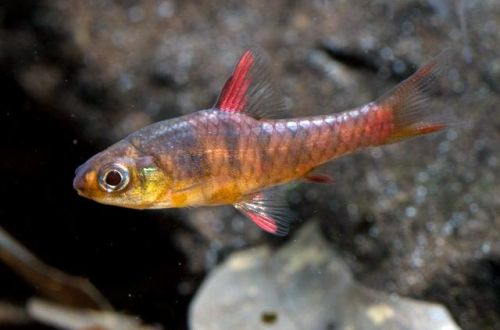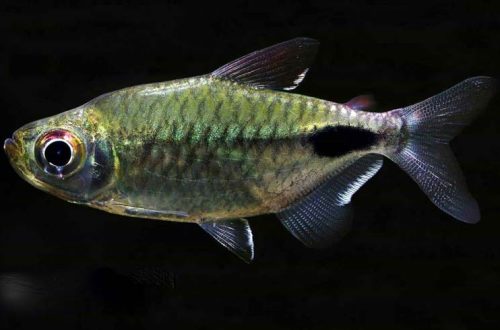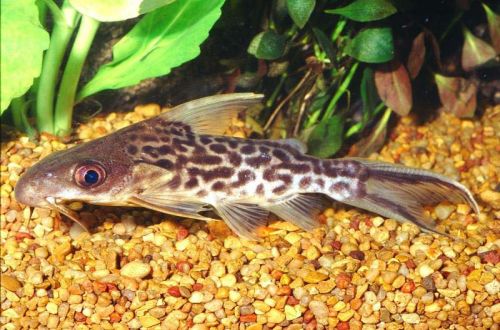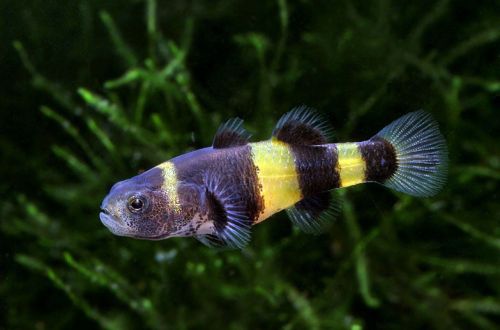
Barbus Jae
Barbus Jae, scientific name Barbus jae, belongs to the Cyprinidae family. A miniature bright fish that can become the main decoration of a small aquarium. Easy to keep and breed, compatible with other species of similar size. May be recommended for beginner aquarists.

Contents
Habitat
Comes from equatorial Africa. The natural habitat is shallow rivers, streams, swamps, located under the canopy of the tropical forest, with dense aquatic vegetation. The water has a rich “tea” shade due to the abundance of tannins – the result of the decomposition of fallen plant organic matter (leaves, branches, tree trunks).
Brief information:
- The volume of the aquarium – from 40 liters.
- Temperature – 17-24°C
- Value pH — 5.0–6.5
- Water hardness – 1–5 dGH
- Substrate type – any soft
- Lighting is weak
- Brackish water – no
- Water movement is weak
- The size of the fish is about 4 cm.
- Feeding – any food of suitable size
- Temperament – peaceful
- Keeping in a group of 8-10 individuals
Description
Adult individuals reach a length of up to 4 cm. Males have a bright color with a predominance of red flowers. Depending on the region of origin, the color may vary. For example, fish from the territory of Cameroon are distinguished by blood-red hues, while representatives from Gabon are mostly gray, and only fins are painted red. Females look much more modest.
Food
An omnivorous species, in a home aquarium it will accept most popular foods (dry, freeze-dried, live, frozen). When choosing food, preference should be given to products from well-known and trusted manufacturers, since the health of the fish and their color largely depend on the quality of the food.
Maintenance and care, arrangement of the aquarium
The optimal size of the aquarium for a small flock of these fish starts from 40 liters. The design uses soft substrates, various shelters in the form of snags and a large number of aquatic shade-loving plants, including floating ones. The latter serve as an additional means of shading. The lighting is subdued.
The addition of dry leaves will give the design a natural look, and also color the water brownish by saturating it with tannins, which is typical of the natural habitat of Jaya barbs. Read more in the article “Which tree leaves can be used in an aquarium.”
Successful keeping is possible in soft acidic water. Maintenance of the aquarium consists of several standard procedures: weekly replacement of part of the water with fresh water, cleaning the soil and decor elements from organic waste / plaque, equipment maintenance, monitoring and maintaining stable pH / dGH / oxidizability values.
Behavior and Compatibility
Peaceful calm fish, compatible with other non-aggressive species of comparable size. It is recommended to purchase a heterosexual group of at least 8-10 individuals. Intraspecific relationships are built on the dominance of alpha males, so weak individuals often try to hide from the attention of stronger neighbors.
Breeding / breeding
This species of Barbs has retained the seasonality of reproduction, despite the fact that many generations of these fish have been living in the artificial environment of aquariums. Under favorable conditions, spawning occurs twice a year – from March to June and from September to November. Like most cyprinids, females scatter eggs in the water column, and males fertilize them. The incubation period lasts up to 7 days. Parental instincts are not developed, so adult fish tend to eat their own offspring. For this reason, if no measures are taken, the survival rate of juveniles will be extremely low.
In order to preserve fry, experienced aquarists prepare separate tanks in advance, the so-called spawning aquariums. Usually, this is a small container with a volume of 10 liters or more, in some cases a simple three-liter jar filled with water from the main aquarium will come in handy. The set of equipment consists of a heater and a simple airlift filter with a sponge. A separate light source is not required. Any decor. It is recommended to place already used tree leaves on the bottom. They can become a valuable source of food, since in most cases they contain colonies of shoe ciliates, which fry can eat in the first days of life.
Fish diseases
In a balanced aquarium ecosystem with species-specific conditions, diseases rarely occur. Diseases are caused by environmental degradation, contact with sick fish, and injuries. If this could not be avoided, then more about the symptoms and methods of treatment in the section “Diseases of aquarium fish”.





